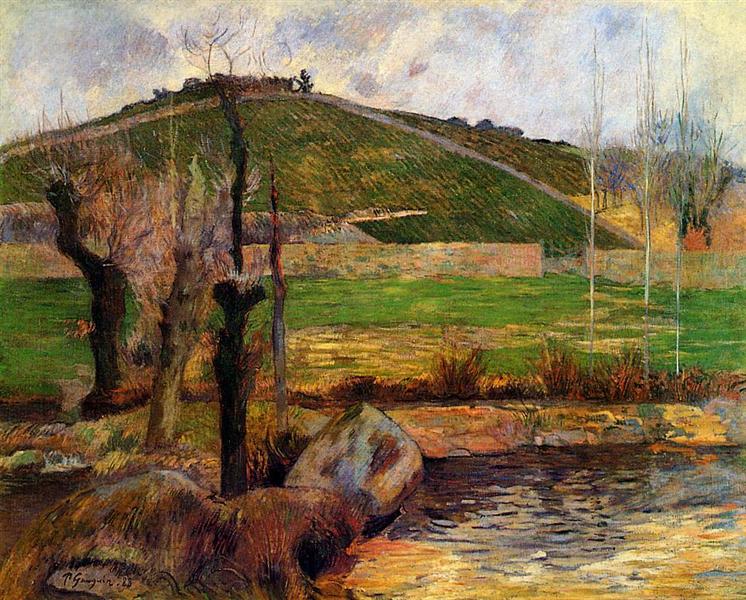Description
The work "Río Aven under the Saint Marguerite mountain" (1888) by Paul Gauguin is an intimate and evocative representation that encapsulates the essence of the artist in his post -impressionist period. It is located in the Brittany region, where Gauguin sought the loneliness and authenticity of rural life, moving away from the agitation of the urban life of Paris. The painting reflects a fascination with natural landscapes and local culture, elements that characterize Gauguin's work, who was always in search of emotional essence through coloring and shape.
In the foreground, the Avena River serpentes gently, its surface reflects the light and establishes a visual anchor point that invites the viewer to explore the painting. This representation of water, with its nuances of blue and green, becomes a symbol of the flow of life, a recurring theme in Gauguin's work. The composition develops towards a mountainous background that acquires different layers of color, manifesting its distinctive color application technique, where each brushstroke seems to vibrate with its own life. The mountains, although stylized and abstract, establish a radical contrast with the fluidity of the river, emphasizing the duality between the mainland and moving water.
The use of color in this work is particular. Gauguin favors a palette that includes saturated and vivid tones, mainly green, blue and yellow. These colors not only fulfill a descriptive function, but evoke emotions and moods, something that the artist explored deeply in his career. The way the painter mixes the colors also about the painting To the experience of dreams, a search for the symbolic that transcends the mere representation of the landscape.
As for the human figure, although the work does not present characters in a conventional narrative sense, a connection with the environment can be evidenced. Gauguin often sought to express sections of peasant life and the relationship of man with nature, which could suggest an implicit narrative of communion with the space represented. This work, like many of Gauguin, can be interpreted not only as a landscape, but as a reflection on the existence and search for meaning in the natural environment.
"Río Aven under the Saint Marguerite mountain" is also notable for its proximity to the evolution of Gauguin's style, who began to move away from the strictest patterns of impressionism towards a form of symbolism loaded with meaning. paintings Similar to this period, such as "the vision after the sermon" or "the Dutch", also show this transition to a more subjective art, which does not only seek to represent visual reality, but also the emotions and perceptions of the subjects.
When observing this landscape, it is difficult not to be attracted to the subtlety of the game between light and shadow, the movement of water and the majestic silence of the mountains that surround it. The river, on its way through the canvas, becomes a metaphor for the flow of time and existence. The work is a testimony of Gauguin's ability to merge reality with perception, promoting the viewer to meditate on the connection between the human being and its surroundings.
Through "Río Aven under the Saint Marguerite mountain", Gauguin not only captures a time in time, but also offers an aesthetic experience rich in symbolism and color, inviting contemplation and a renewal of astonishment in front of beauty natural. This highlights its fundamental place within the history of art, as a pioneer who sought new forms of expression to resonate with the depth of human experience.
KUADROS ©, a famous paint on your wall.
Hand-made oil painting reproductions, with the quality of professional artists and the distinctive seal of KUADROS ©.
Reproduction service paintings With a guarantee of satisfaction. If you are not completely satisfied with the replica of your painting, we refund your money 100%.

